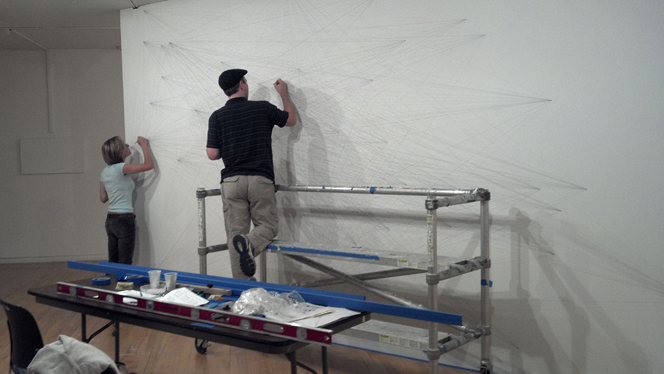….. with Assignment 1, that is.
Now, it is time for me to catch up on sleep.

Besides Agnes Martin, I actually looked up on Ed Moses and a little bit on Sol LeWitt. So I went to the ADM library and borrowed these books (see below) for further reference.
Although the research of these 2 artists are brief, I managed to get some information about them and their techniques.
First of, we have Sol LeWitt.
Sol LeWitt is a leading figure of Minimalism and pioneer of Conceptual art. LeWitt’s work is characterized by serialization, repetition, and progression, exemplified by his iconic open-grid structures. LeWitt’s wall paintings are just about the same as Agnes Martin, lines are mathematically drawn. In LeWitt’s case, once he does the calculations and planning, he would get his assistants to carry out the work for him with specific instructions.


I actually watched a documentary before about LeWitt’s art techniques and how he works in the industry. They actually showed his assistants working on the installation — not 1 or 2, but at least 4 people working on a wide wall.
Next, Ed Moses, the artist.
![[CLOSE UP] Monographs of Ed Moses (and the process of his art-making) by Radius Books.](http://oss.adm.ntu.edu.sg/ummi0001/wp-content/uploads/sites/329/2015/09/EDMOSES_1.jpg)
I considered myself lucky to have found the book (see above) in the ADM library. Although the weight was a total burden, I had to do what I had to do for research — BORROW IT!
In the book contained bits and pieces of the artist, his artworks, and FAQs. I admit I was solely interested in his artworks besides anything else. But I picked up a few information from the book as well.
Ed Moses…..
Techniques
Interesting information of his techniques are actually the materials he used for his artworks. As stated above, he uses unusual materials like raw mahagony and unstretched canvas; unusual tools like long-handled mops, sponges and squeeges, besides normal rollers and brushes.
(There’s more…)
Moses also used….
Here are some snapshots of his artworks from the book. (I should have done proper citation of the images. My bad!)

Most of the time when I continued to flip the pages, I was in awe with how contrasting and bold Moses’ artwork are.
In conclusion with these 2 artists, I mainly looked at their artworks for inspiration and motivation to continue coming up with whatever I have at the back of my mind. I didn’t really plan to follow this artist to that type of art piece, I just do without thinking. Then when Prof Ina mentioned mine had some of Agnes Martin’s work in the monoprint etc, I was like…… “really?”
Funny how I didn’t even realised that!
Here is a compilation of the time lapse clips I took throughout the journey of the Lines assignment!
After consultation, I retake my photos to include myself in the pictures. This time round was emphasizing on the fragments of the polaroid.
These fragments shows about what I like or what I own or anything about me related to the place etc. For example: my room, my garden-that-I-walk-pass-everyday, my friend, my favourite past time, my view from my window, my #OOTD, and my view from the roof.
At the end of the day, after setting up the films on the wall, I felt rather accomplished that I managed to complete this assignment. I mean, don’t you feel great looking at your photos nicely set on the wall, imagining it to be in the museum gallery or exhibition?
*self pat on my back*